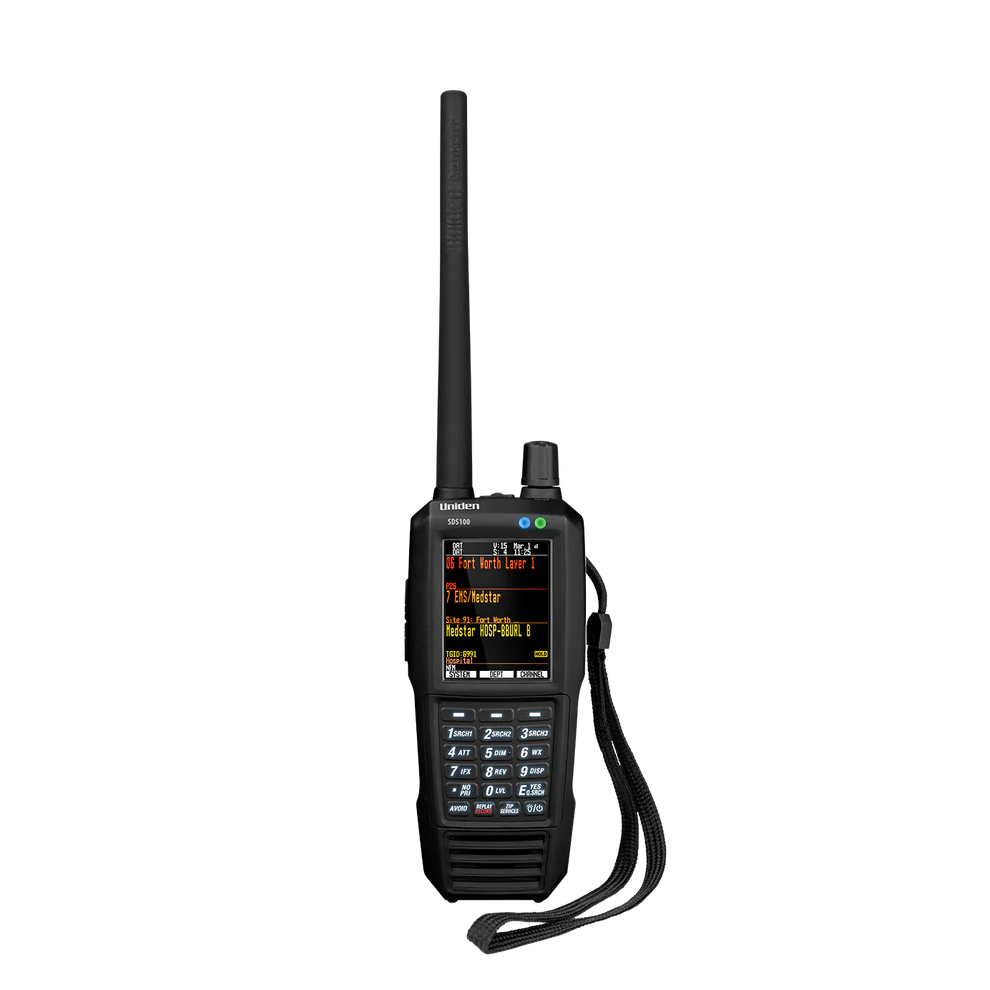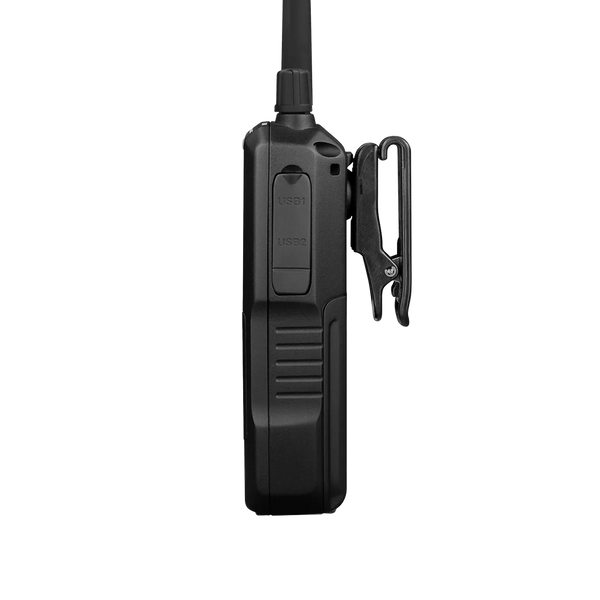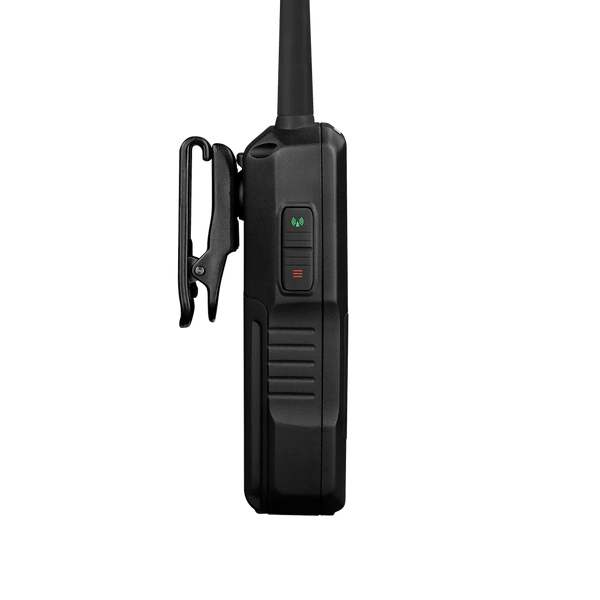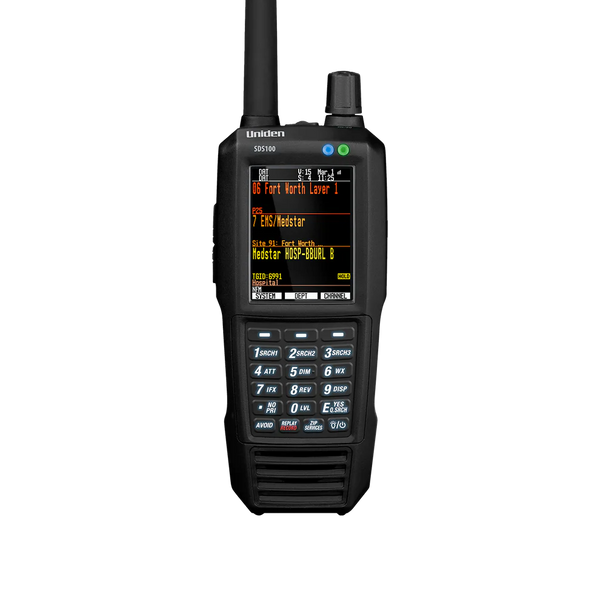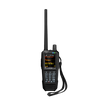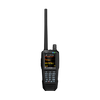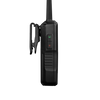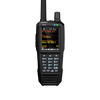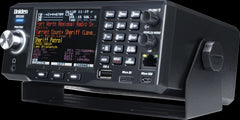Uniden Bearcat SDS100 Digital Handheld Police Scanner
Availability:In stock
Have a question?
If you’re looking for a scanner that can keep up with the chaos of modern radio systems, the Uniden SDS100 is your guy. This isn’t just any scanner—it’s a True I/Q™ beast that’s built to tackle the toughest digital signals, even in those tricky simulcast and weak-signal spots where other scanners just give up and cry. Imagine you’re out in a busy city or some rural nowhere, and this thing’s still picking up crystal-clear chatter. It’s like having a superpower for eavesdropping on public safety, ham radio, or even NASCAR if that’s your vibe.
Why It’s Awesome
True I/Q Receiver: This is the secret sauce. It grabs the full signal waveform in 3D (yeah, sounds fancy, right?), which means better digital performance. No more garbled audio when you’re trying to hear the fire department during a storm. It’s a game-changer for simulcast systems that drive other scanners nuts.
HomePatrol Database: Out of the box, it’s got every known radio system in the US and Canada loaded up. Just punch in your zip code, and boom—you’re scanning. No need to geek out over frequencies unless you want to. Perfect for newbies or folks who just wanna plug and play.
Customizable Color Display: You can tweak what shows up on the screen, where it goes, and even what color it’s in. Want your police channels in blue and fire in red? Go for it. It’s like customizing your phone’s home screen but for scanner nerds.
Rugged and Weather-Resistant: Built to JIS4 (IPX4) standards, this thing can handle a splash or two. Think rainy festival or dusty campsite—it’s not gonna quit on you. Feels solid in your hand, too, like it’s ready for an adventure.
TrunkTracker X: It tracks APCO 25 Phase 1 and 2, X2-TDMA, Motorola, EDACS, and LTR systems, plus analog and P25 digital channels. Basically, it speaks every radio language out there (except encrypted stuff, sadly—more on that later).
Key Features
Frequency Range: Covers 25–512 MHz, 806–960 MHz, and 1240–1300 MHz. From ham radio to aviation, it’s got you covered.
GPS Compatibility: Hook it up to a GPS (sold separately), and it’ll auto-pick channels based on where you are. Road trip? No problem—it’ll keep up as you cross state lines.
MicroSD Card: Comes with a 1GB card (supports up to 32GB) for storing your settings, recordings, and favorite lists. It’s like a mini hard drive for your scanner.
Close Call RF Capture: This feature sniffs out nearby signals automatically. Great for finding new frequencies when you’re out in the field, like stumbling on a cool new band at a music festival.
Optional Upgrades: Wanna listen to DMR, NXDN, or ProVoice? You can buy activation keys from Uniden’s site. It’s a bit of an extra cost, but it opens up a ton more channels, especially for business or niche systems.
Sentinel Software: Free download for programming and firmware updates. It’s PC-based (sorry, Mac users, it’s a bit clunky on your end for now). Makes tweaking your scanner a breeze once you get the hang of it.
Real Talk: The Good, The Bad, and The Battery
This scanner’s a champ, but it’s not perfect. The battery life? Kinda like your old phone—drains faster than you’d hope. Expect about 6–7 hours with the included 5400mAh battery, especially if you’re cranking the bright display. Heavy users are gonna want the external charger kit (comes with an extra battery) to keep the party going. I’ve heard folks on forums like RadioReference gripe about going through three batteries a day if they’re glued to it. Pro tip: grab a couple of spares if you’re selling to avid listeners.
Programming can feel like wrestling a bear at first. The menu’s not the most intuitive, and the manual? Let’s just say it’s not winning any awards for clarity. If your customers are new to scanning, point them to Mark’s Scanners manual online—it’s a lifesaver. Or, better yet, offer pre-programming as a service (cha-ching!). Some resellers like Bearcat Warehouse do this, and customers eat it up because it’s ready to go out of the box.
Oh, and the internal speaker? It’s… okay. Fine in a quiet room, but if you’re in a noisy environment, it’s like trying to hear a whisper at a rock concert. A lapel speaker or Bluetooth transmitter can fix that, but it’s another accessory to upsell. Also, some folks say it’s a bit noisy on fringe VHF/UHF signals compared to older models like the BC346XT. Not a dealbreaker, but worth mentioning for the purists.
Why You Will Love It
This scanner’s for anyone who’s serious about staying in the loop—think preppers, ham radio buffs, or that guy who’s always chasing storm updates. It’s a beast for picking up P25 simulcast systems, which is a big deal in metro areas where other scanners choke. I remember a customer telling me how their old scanner couldn’t handle the local police chatter because of simulcast distortion, but the SDS100 was like flipping on a clear HD channel. Night and day.
Final Thoughts
The SDS100 is like the Swiss Army knife of scanners—versatile, powerful, and a little intimidating at first. It’s perfect for tech-savvy hobbyists or professionals who need top-tier performance. Sell it with confidence, but be upfront about the learning curve and battery life. Toss in some accessories like the external charger or a better antenna (the stock one’s decent, but a Diamond RH519 can boost reception), and you’ve got a happy customer. This thing’s been the top dog since it dropped, and with firmware updates and add-ons, it’s still king in 2025.
FAQs
1. What makes the SDS-100 stand out from regular scanners?
It’s the first handheld scanner with True I/Q (Software-Defined Radio) technology, delivering superior digital performance in challenging environments. It’s also built tough and weather-resistant (JIS4/IPX4) and taps into the HomePatrol database for coverage in the U.S. and Canada.
2. How do I get started—like, get it to scan my area?
After powering up, hit the MENU button, select “Set Your Location,” and either enter your ZIP code or use GPS or auto-locate options to start scanning local systems quickly.
3. What’s included in the box when I buy it?
You'll receive the scanner, belt clip, USB cable, a pre-installed microSD card, and a second-generation, high-capacity lithium-ion battery.
4. Can it handle trunked systems and digital modes?
Absolutely—its TrunkTracker X system supports APCO 25 (Phase 1 & 2), Motorola, EDACS, LTR, and conventional analog channels. It also handles simulcast environments really well.
5. How is the SDS-100 updated?
Use Uniden's Sentinel software on your PC to download firmware and database updates. Updates are released weekly to keep your scanner current.
6. Is the scanner durable enough for field use?
Yes—the SDS-100 meets IPX4/JIS4 weather-resistant standards and is built to withstand splashes and light weather conditions.
7. How long does the battery last?
You can expect around 8 hours of continuous use on the included lithium-ion battery.
8. What’s this “Close Call” feature?
Close Call RF Capture detects nearby radio transmissions even if they’re not programmed into the device—great for discovering active frequencies around you.
9. Can I program it on a Mac?
Not directly. The SDS-100 is compatible with PC only for Sentinel software and programming.
10. What’s the scanning range like?
Its true range varies—but under ideal conditions, you can expect up to 50 miles reception line-of-sight. Terrain, obstructions, and antenna quality all make a difference.


